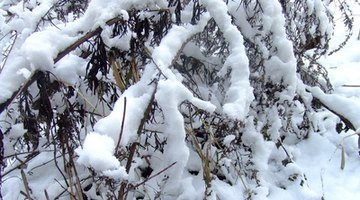Termites & Freezing Temperatures
Table of Contents
Termites are a common pest in warmer areas of the world, particularly tropical climates. Colder climates suffer from these insects less, but they are still present. Because termites are slower and less active in the cold, some people have attempted to use cold as a means of pest control.

Freezing temperatures won't kill termites in all situations, but they may be helpful in some cases.
Effects
Freezing outdoor temperatures cause subterranean species of termites to retreat underground to overwinter. According to Ohio State University, temperature has a strong influence on termite activity--both on a daily and seasonal basis. Subterranean species don't forage for food when temperatures are too cold or too hot. Termites exposed to freezing temperatures without shelter are usually killed within a short period of time.
Control
Cold can be used to control drywood termite species, which live their whole lives within a single piece of wood, such as a chair, a board in a home or a picture frame. Since these termites have enclosed colonies, freezing the affected object can kill the insects, preventing further damage to the wood. According to the University of California, subterranean termites cannot be effectively controlled by freezing, since they maintain large colonies underground.
Considerations
Freezing temperatures are not as effective at termite control as many pesticides, but they do not present the possible toxic and environmental dangers that conventional termite control methods do. For people suffering only from small, contained infestations of drywood termites, cold may be an effective method of control. Possible problems from this technique include damage to nearby pipes and building materials.
Prevention/Solution
Some people simply place affected objects outside during cold weather to kill termites, but this is less effective than professional cold treatment. According to the University of California, wood should be chilled to minus 20 degrees Fahrenheit for at least 30 minutes to kill the termites inside. Liquid nitrogen is commonly used for this purpose.
Warning
Do not allow termite colonies to persist untreated. Natural cold will not take care of the problem. Termites can cause significant damage to crops, structures and natural wood. Eventually, they may even compromise the structural integrity of your home. If you believe that you have termites in or around your home, take steps to eliminate them.
The Drip Cap
- Termites are a common pest in warmer areas of the world, particularly tropical climates.
- Freezing outdoor temperatures cause subterranean species of termites to retreat underground to overwinter.
- According to the University of California, subterranean termites cannot be effectively controlled by freezing, since they maintain large colonies underground.
- Some people simply place affected objects outside during cold weather to kill termites, but this is less effective than professional cold treatment.
- Do not allow termite colonies to persist untreated.
References
Writer Bio
G.D. Palmer is a freelance writer and illustrator living in Milwaukee, Wis. She has been producing print and Web content for various organizations since 1998 and has been freelancing full-time since 2007. Palmer holds a Bachelor of Arts degree in writing and studio art from Beloit College in Beloit, Wis.
Photo Credits
- snow 2 image by Omely from Fotolia.com
- snow 2 image by Omely from Fotolia.com
More Articles



